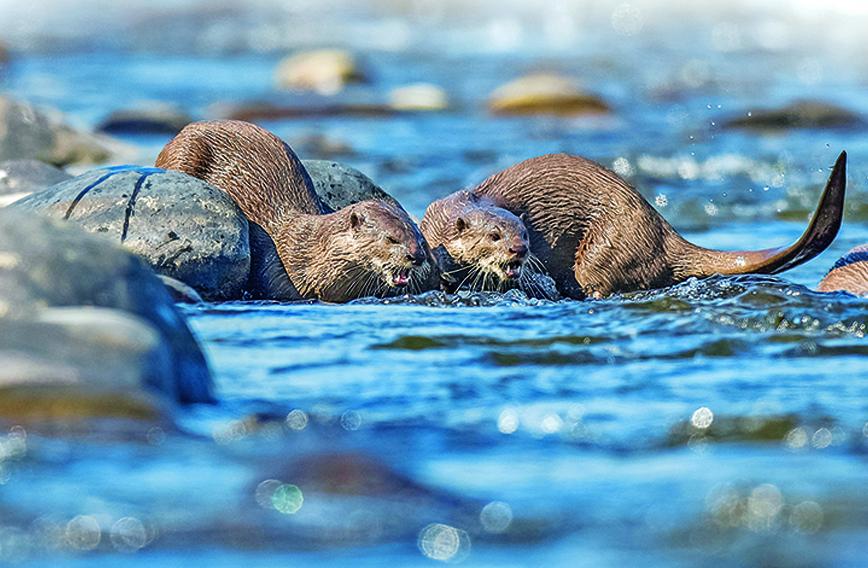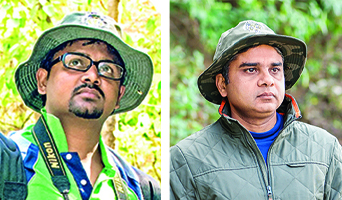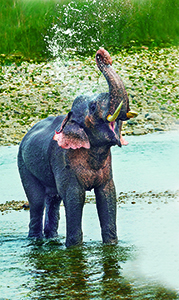
Smooth-coated otters enjoy a splash in the Ramganga river
Discovering the ecosystem of the tiger in Corbett
Sukanya Sharma
ANY mention of Corbett Park tends to be about its tigers and Jim Corbett, the colonial game hunter after whom it is named. But what about plants, trees, butterflies, birds and animals that also inhabit this reserve? Surely there must be more to the world of the tiger than is generally acknowledged.
There really is and though perhaps not as magnificent as Corbett’s star attraction, they make up a teeming ecosystem waiting to be discovered and without which the tiger itself would not be around.
 |
| Vinesh Kumar and Rajesh Chaudhary |
Setting the record right is a photographic guide by Rajesh Chaudhary who has a PhD in biological science and Vinesh Kumar, a keen nature photographer committed to the cause of conservation.
“There is plenty of nature to observe, imbibe and photograph. Yet every safari trip ends in tiger-talk among visitors. Our instant reaction was to portray the less sought after natural treasures of Corbett Tiger Reserve,” say the authors.
So, for anyone off for some tiger watching, here is a guide that will help them see a lot else as well — not just in the reserve but in the Himalayan foothills generally which abound in natural beauty.
Wildlife In and Around Corbett Tiger Reserve is in three sections: “Prelude”, “Animals and Plants” and, finally, “Visiting CTR”.
“Prelude” has details about the natural and historical settings of the Corbett National Park, the scientific names and identification of organisms and a comprehensive glossary with important abbreviations.
“Animals and Plants” identifies features of the park and has photographs of scores of animals and plants that the reserve and its surrounding areas are home to.
The final segment provides all the details that a visitor to the Corbett Tiger Reserve might require such as route maps, eco-zones, dos and don’ts, jungle clues and pugmarks to watch out for.
It is an easy read with a lot of ready-to-access documentation. So, it is a guide in content, touch and feel. It curates information from the latest scientific publications but leaves out technical terms and jargon.
 |
| Baby elephant cooling off |
With more than 1,500 photographs of over 700 species of animals (including mammals, birds, reptiles, amphibians, butterflies) and plants, the guide is comprehensive and well-researched, making it possible to explore the reserve before getting there.
The section on animals begins with a description of the mammals inhabiting the reserve. There is the sloth bear, primarily a solitary animal. Mother bears carry cubs on their backs for as long as nine months, sometimes refusing to let them down even during their daily activities. The reserve is also home to smooth-coated otters. These playful creatures thrive in water and on land. Another remarkable mammal is the red giant flying squirrel, an excellent glider that preys on small cats and owls.
The guide includes a checklist of 496 birds seen in and around the CTR. This section is vibrant and vivid. It includes the painted stork with its artistic feathers, the aesthetic hues of bee-eaters and five diverse woodpeckers with their own drumming sounds.
The CTR also has some spectacular reptiles. Around 18 of the three dozen snake species that have been recorded in the area are presented to the reader. The authors warn visitors to stay away from piles of wood and to always wear ankle boots, emphasizing that snakes are cryptic animals that tend to remain motionless. The reader is introduced to some magnificent butterflies along with tips on how to identify and photograph them. The authors emphasize that butterfly watching is an engaging pastime.
 |
| Indian Roller |
The section on plants documents more than 60 species of trees and 80 shrubs and herbs. The CTR has some splendid trees in and around its buffer zone. The monkey-face tree helps dye silk, is used in traditional medicine and is regarded as auspicious for Hindu rituals. There is also the sacred putranjiva tree whose seeds are made into necklaces to protect children from disease.
The CTR abounds in shrubs and herbs used in traditional medicine. The false daisy is a herb that has traditionally been used to prevent greying of hair, hair loss and for treatment of asthma. Oil from the woodworm is used in folk and modern medicine. There are many more such shrubs and herbs.
There is also the catweed, “an aggressive colonizer native to tropical America which has invaded several parts of India”. Also included are details of the blue-violet flowers, their scientific names and conditions in which they are typically found. We have here an absorbing compendium of flora and fauna of the Himalayan foothills.
The latter part of the book is a virtual tour of the reserve with details of its seven ecotourism zones, route maps and ideal seasons for a visit. It also offers a list of suggestions and code of conduct to be followed, photography tips, guides to jungle clues and pugmarks, and finally, incredible excursions.
Comments
Currently there are no Comments. Be first to write a comment!



